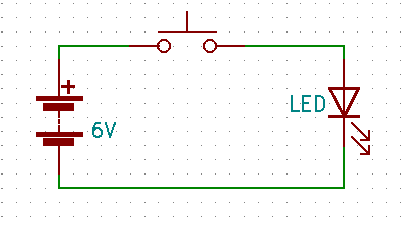I am trying to design a circuit that uses 6V coin cell battery to turn on and off a white LED. A single button press should turn the LED on/off. Would an analog switch of some kind accomplish this? I would like the component to draw as little current as possible.

-
1\$\begingroup\$ Look up flip-flop and a MOSFET. Where's your current limiting resistor? \$\endgroup\$– TransistorCommented Jan 26, 2022 at 16:58
-
\$\begingroup\$ @Transistor I didn't think a current limiting resistor would be necessary in this application. The LED would only be on for minutes at a time. \$\endgroup\$– earlCommented Jan 26, 2022 at 17:01
-
1\$\begingroup\$ Driving a ~3.7V white LED with 6V will burn it out in milliseconds. \$\endgroup\$– virCommented Jan 26, 2022 at 17:06
-
1\$\begingroup\$ Coin cell batteries may have very large output resistance in comparison to other batteries, but it still does not mean the LED or the batteries should be abused with out-of-spec currents. \$\endgroup\$– JustmeCommented Jan 26, 2022 at 17:17
-
1\$\begingroup\$ lednique.com/current-voltage-relationships/iv-curves may be of interest. For LEDs you must control the current. You just might get away with it using weak coin cells for reasons that are explained here. \$\endgroup\$– TransistorCommented Jan 26, 2022 at 18:30
2 Answers
If you want to use an IC then you could look at a 4013 wired as a toggle type flip flop. The asynch R and S pins can be used for initial powerup state. It is best to use a transistor to run the led from the chip and current limiting is wise.
There are switches that open/close by pushing at the same place. For example that one (first one I found, up to you to decide if you want one to be mounted on PCB or nor, the size, ...)
You have basically 2 sub-types that match your question :
- if you push once, the putton is "pushed in", if you push again, it is pushed out. This is the type I put in the link. You find those for example on old analog scopes.
- if you push, the button changes state (on/off), but mecanically springs back to the same position for the visible part
But in both cases, you will probably need to add a resistor in series with your LED (excepted if you buy one with intergrated resistor), or use something more sofisticated in order to keep the same current (therefore light intensity) while the voltage decreases.
-
\$\begingroup\$ Bb15 is momentary not locking. \$\endgroup\$– PasserbyCommented Jan 26, 2022 at 23:05
